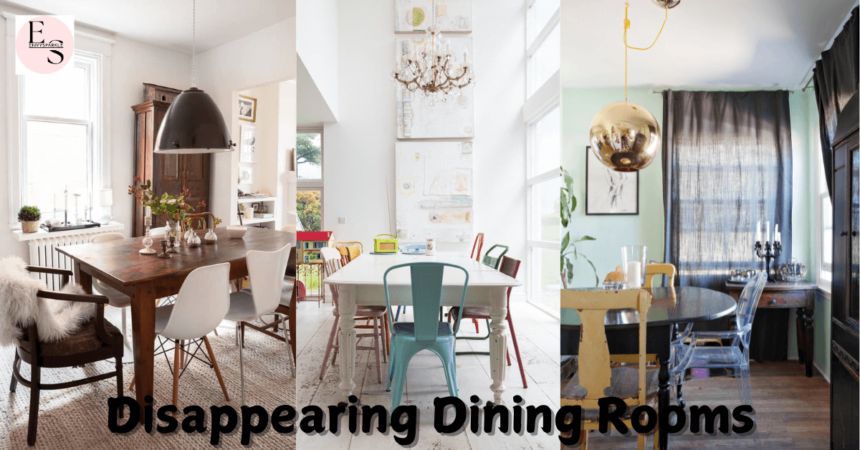The dining room, once a central feature of family homes, is quietly vanishing from modern architectural design. In the past, it was the heart of family meals, formal gatherings, and celebrations, serving as a space where families connected and entertained guests. However, the rise of open-concept living, the need for efficient use of space, and changing dining habits have led to the disappearance of the traditional dining room. This article explores the reasons behind this shift, its impact on the way we live and interact, and what the future holds for dining spaces in our homes.
The Evolution of the Dining Room
Historically, the dining room was a formal, often elegant space reserved for special occasions such as holiday feasts, Sunday dinners, or hosting guests. In many older homes, it symbolized hospitality and status, showcasing fine furniture, decorative art, and a sense of occasion. Families would gather to enjoy meals together, away from distractions, creating opportunities for meaningful conversation and connection.
However, as lifestyles have evolved, the role of the dining room has changed. The traditional family meal, with everyone seated at the same time around a table, has become less common. With the advent of busy schedules, fast food, and quick meals, the dining room has become more of a luxury than a necessity. In many modern homes, it is rarely used except during holidays, making it an expendable feature in contemporary home design.
Dining Rooms Disappearing: From Essential to Expendable
As the way people live and eat has shifted, the dining room has gradually become an expendable part of the home. Today’s homeowners are increasingly opting for more casual and flexible living arrangements that do not require a dedicated space for formal dining. The traditional walled-off dining room, once a staple in home design, is being replaced by open-concept layouts where the kitchen, dining, and living areas blend into one seamless space.
This transition reflects broader changes in how families interact with their living spaces. Instead of formal sit-down meals in a separate room, modern families prefer informal, casual settings such as kitchen islands, breakfast bars, or even couches in front of the TV. This trend towards more relaxed dining habits is a key driver behind the disappearance of dining rooms in modern homes.
Why Are Dining Rooms Disappearing?
1. Shift to Open-Concept Living
One of the main reasons for the disappearing dining room is the popularity of open-concept living. Modern homeowners favor open, flowing spaces that merge the kitchen, dining, and living areas into one unified environment. This design promotes connectivity, allowing family members to cook, eat, and socialize in a single space.
Open-concept living aligns with today’s more casual lifestyle, where formality is often eschewed in favor of convenience and flexibility. Kitchen islands or breakfast bars often double as informal dining spaces, rendering a separate dining room unnecessary. This layout also enhances social interactions, as family members can engage with one another while performing different tasks, from preparing meals to helping with homework or simply relaxing.
2. Smaller Homes and Apartments
Urbanization and rising housing costs have led to smaller homes and apartments, where every square foot matters. In these spaces, developers focus on maximizing living and bedroom areas, often at the expense of dedicated dining rooms. For homeowners or renters in cities, dining may take place at the kitchen counter, a small table in the living room, or even on the couch.
The shrinking size of homes is a practical factor driving the decline of formal dining rooms. With limited space, homeowners prioritize functionality over tradition, using multi-functional furniture and spaces to serve multiple needs. Dining areas, if present, are often informal and integrated into the main living area.
3. Changing Dining Habits
Perhaps the most significant factor contributing to the disappearing dining room is the shift in dining habits. Families no longer adhere to rigid meal times or formal dining traditions. Instead, many people eat on the go, at different times, or in various parts of the house, such as in front of the television or at a kitchen counter.
The rise of meal delivery services, fast food, and ready-to-eat options has also reduced the need for a formal dining area. People prefer quick, informal meals that fit into their busy schedules, further diminishing the role of the dining room in daily life.
The Impact of Dining Rooms Disappearing
1. Loss of a Gathering Space
The disappearance of dining rooms goes beyond a mere architectural change—it affects how families interact and bond. Dining rooms were traditionally spaces where families gathered, shared meals, and made memories. Without this dedicated space, families may lose opportunities for these moments of connection.
In smaller homes where even a dining table may be missing, hosting family meals or gatherings can be challenging. This lack of communal dining spaces can contribute to a sense of isolation, as the shared experience of sitting down for a meal together becomes less frequent.
2. Designing Loneliness into Homes
As dining rooms disappear and communal spaces shrink, there is concern that modern homes may be inadvertently designed for loneliness. Eating alone or in front of screens has become more common, reducing the chances for meaningful social interaction. While open-concept living promotes casual interaction, the absence of a dedicated dining area may mean fewer shared meals and family experiences.
3. The Rise of Multi-Functional Spaces
In response to the disappearing dining room, many homes now feature multi-functional spaces that can adapt to different needs. Kitchen islands serve as informal dining spaces while living rooms double as areas for eating, entertaining, and relaxing. Furniture designers have also embraced this trend, creating pieces that can transform from dining tables to workstations or entertainment centers, reflecting the need for flexibility in modern homes.
The Future of Dining Rooms: A Comeback or Continued Decline?
As dining rooms continue to disappear from modern homes, the question remains: will they ever make a comeback? While the traditional, walled-off dining room may be fading, there is still a desire for spaces where people can gather for meals and socialize. The future may see dining rooms taking on a more flexible form, blending with other living areas or serving multiple purposes.
1. Flexible Dining Spaces
In the future, dining rooms may evolve into more versatile spaces that can adapt to the needs of modern families. Dining tables that fold away or double as workstations, or dining areas integrated into open-plan layouts, could become common solutions for homeowners who still value a dedicated space for meals.
2. Outdoor Dining Areas
As outdoor living becomes more popular, many homeowners are creating dining spaces on patios, decks, or balconies. Outdoor dining areas offer a casual, relaxed setting for meals, allowing families to enjoy both nature and each other’s company. This trend could compensate for the loss of formal dining rooms by providing an alternative space for shared meals.
Conclusion
The dining room disappearing is a reflection of broader changes in how we live, eat, and interact within our homes. While the traditional dining room may no longer be a staple in contemporary home design, this shift doesn’t signal the end of shared meals or family connection. Instead, it underscores the need for more versatile, multi-functional spaces that can adapt to the demands of modern life.
As home design continues to evolve, homeowners will find new and creative ways to bring people together for meals, whether through open-concept layouts, outdoor dining areas, or innovative furniture solutions. In a world where space is often limited, the key is flexibility—ensuring that even as dining rooms disappear, the tradition of gathering over a meal remains intact.







